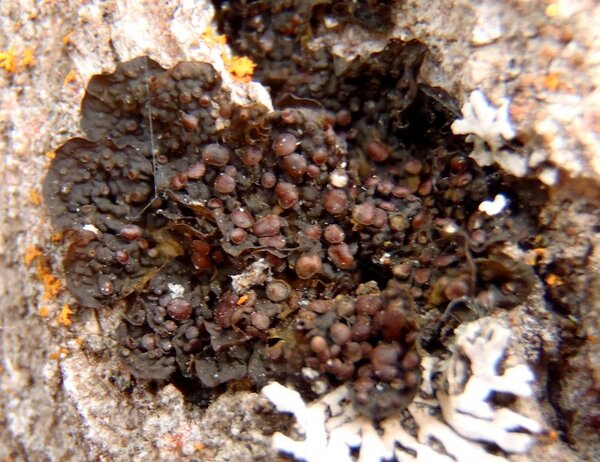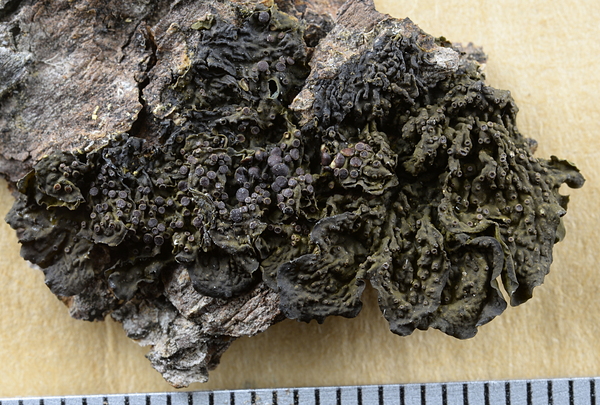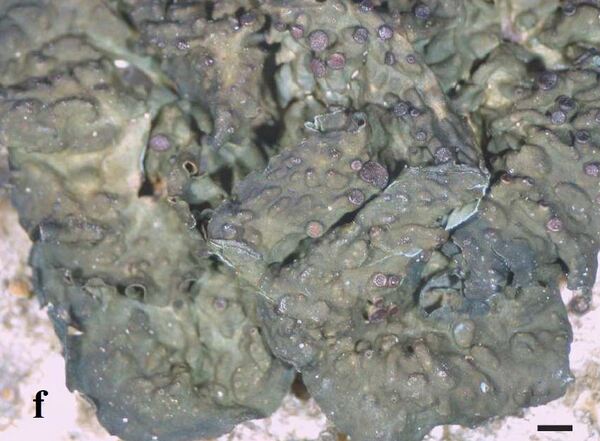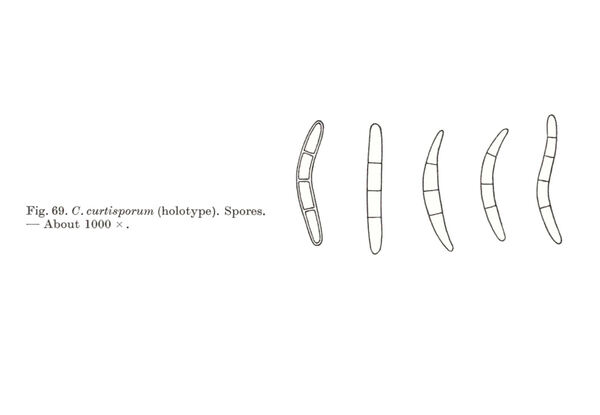Collema curtisporum Degel.
Symb. Bot. Upsal., 13, 2: 437, 1954.
Synonyms:
Distribution: C - Tosc (Brackel 2015, Masson & Bauvet 2021).
Description: Thallus foliose, homoiomerous, subgelatinous when wet, membrane-like, rounded, closely adnate, broadly lobed, 1.5-3(-4) cm wide. Lobes 0.5-0.8(-1) cm wide, 62-160 µm thick when moist, rounded, with an entire, not swollen margin, dark olive-green to black, lighter and semi-translucent when moist, strongly radiately ridged and pustulate. Lower surface paler green than upper surface, at times bluish green, with depressions corresponding to ridges, and scattered white hapters. Upper and lower cortices absent. Apothecia common, lecanorine, sessile, constricted at base, 0.4-1(-1.5) mm across, with an initially concave, finally convex, red-brown to almost black disc and a thin, smooth thalline margin. Thalline exciple sometimes partly pseudocorticate; proper exciple euthyplectenchymatous, 20-40 µm wide laterally; epithecium brownish; hymenium colourless, 65-85 µm high; paraphyses simple or sparingly branched in upper part, 2.5-3 μm thick at mid-level, the apical cells moderately swollen; hypothecium pale yellow. Asci 8-spored, cylindrical-clavate, the apex strongly thickened, the apical dome K/I+ pale blue, with a downwardly projecting K/I+ deep blue tubular structure. Ascospores 3-septate, not constricted at septa, hyaline, bacilliform with rounded ends, straight or slightly curved, (18-)26-34(-38) x 3-4.5 µm. Pycnidia often numerous, immersed to semi-immersed, on both sides of thallus. Conidia straight, bacilliform or with slightly swollen ends, 4.5-5 x c. 1 µm. Photobiont cyanobacterial (Nostoc, the cells in long chains). Spot tests: all negative. Chemistry: without lichen substances. Note: a mild-temperate to boreal lichen found on bark of broad-leaved trees in humid but open situations; easily mistaken with C. nigrescens or C. subnigrescens, this exceedingly rare species needs further study. It is included in the Italian red list of epiphytic lichens as “Critically Endangered” (Nascimbene & al. 2013c).
Growth form: Foliose, broad lobed
Substrata: bark
Photobiont: cyanobacteria, filamentous (e.g. Nostoc, Scytonema)
Reproductive strategy: mainly sexual
Most common in areas with a humid-warm climate (e.g. most of Tyrrenian Italy)
Commonnes-rarity: (info)
Alpine belt: absent
Subalpine belt: absent
Oromediterranean belt: absent
Montane belt: absent
Submediterranean belt: absent
Padanian area: absent
Humid submediterranean belt: extremely rare
Humid mediterranean belt: absent
Dry mediterranean belt: absent

Predictive model
Herbarium samples
Growth form: Foliose, broad lobed
Substrata: bark
Photobiont: cyanobacteria, filamentous (e.g. Nostoc, Scytonema)
Reproductive strategy: mainly sexual
Most common in areas with a humid-warm climate (e.g. most of Tyrrenian Italy)
Commonnes-rarity: (info)
Alpine belt: absent
Subalpine belt: absent
Oromediterranean belt: absent
Montane belt: absent
Submediterranean belt: absent
Padanian area: absent
Humid submediterranean belt: extremely rare
Humid mediterranean belt: absent
Dry mediterranean belt: absent

Predictive model
| Herbarium samples |
 INDEX FUNGORUM
INDEX FUNGORUM
 GBIF
GBIF






